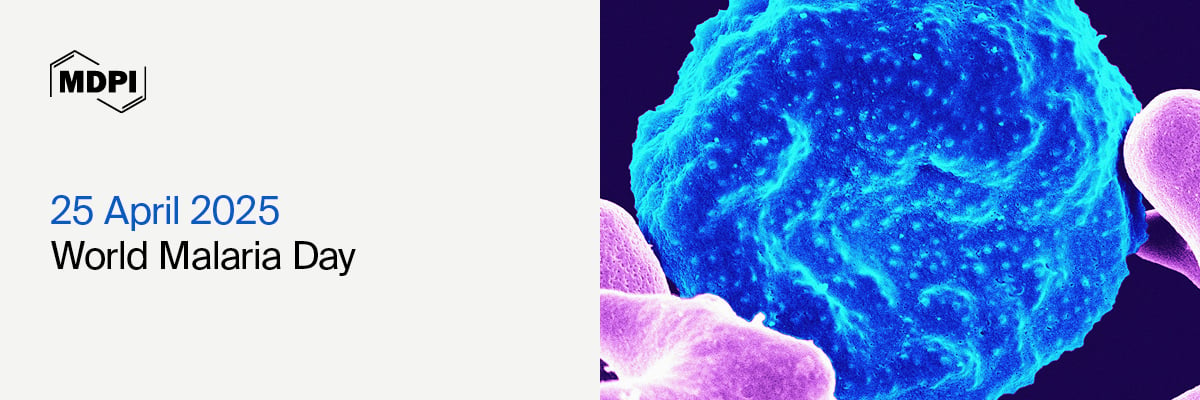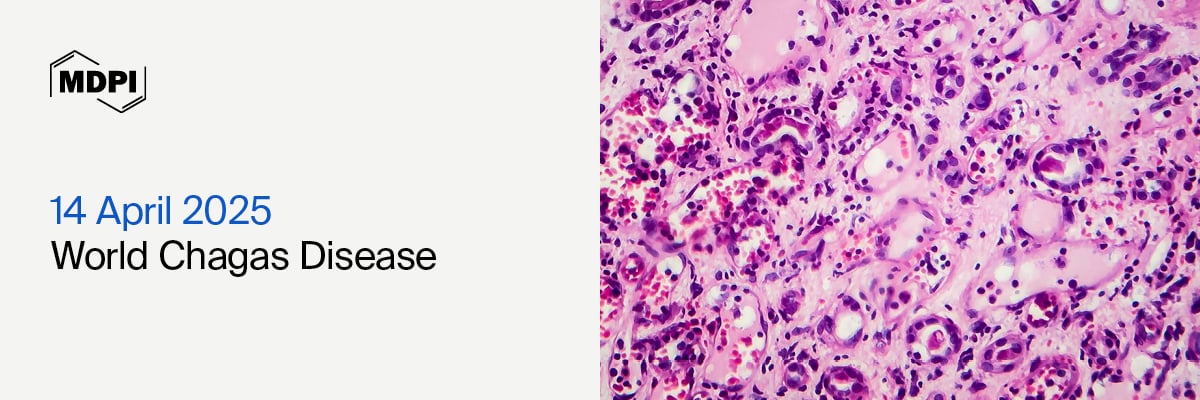-
 Estimating Dengue Outbreak Thresholds in West Africa: A Comprehensive Analysis of Climatic Influences in Burkina Faso, 2018–2024
Estimating Dengue Outbreak Thresholds in West Africa: A Comprehensive Analysis of Climatic Influences in Burkina Faso, 2018–2024 -
 One Health Lens on Rabies: Human–Bat Interactions and Genomic Insights of Rabies Virus in Rural Lilongwe, Malawi
One Health Lens on Rabies: Human–Bat Interactions and Genomic Insights of Rabies Virus in Rural Lilongwe, Malawi -
 Do Statins Affect Viral Infections Encountered by International Travelers?
Do Statins Affect Viral Infections Encountered by International Travelers?
Journal Description
Tropical Medicine and Infectious Disease
Tropical Medicine and Infectious Disease
(TropicalMed) is an international, scientific, peer-reviewed, open access journal of tropical medicine and infectious disease published monthly online by MDPI. It is the official journal of the Australasian College of Tropical Medicine (ACTM) and its Joint Faculties of Travel Medicine and Expedition and Wilderness Medicine. Their members receive discounts on the article processing charges.
- Open Access— free for readers, with article processing charges (APC) paid by authors or their institutions.
- High Visibility: indexed within Scopus, SCIE (Web of Science), PubMed, PMC, Embase, Informit, and other databases.
- Journal Rank: JCR - Q1 (Tropical Medicine) / CiteScore - Q2 (Public Health, Environmental and Occupational Health)
- Rapid Publication: manuscripts are peer-reviewed and a first decision is provided to authors approximately 19.2 days after submission; acceptance to publication is undertaken in 3.7 days (median values for papers published in this journal in the second half of 2024).
- Recognition of Reviewers: reviewers who provide timely, thorough peer-review reports receive vouchers entitling them to a discount on the APC of their next publication in any MDPI journal, in appreciation of the work done.
Impact Factor:
2.8 (2023);
5-Year Impact Factor:
3.0 (2023)
Latest Articles
Evaluation of Ground and Aerial Ultra-Low Volume Applications Using ReMoa Tri Against Deltamethrin-Resistant Aedes aegypti from Collier County, Florida
Trop. Med. Infect. Dis. 2025, 10(5), 119; https://doi.org/10.3390/tropicalmed10050119 (registering DOI) - 26 Apr 2025
Abstract
New intervention methods and product formulations are needed to better control pyrethroid-resistant Aedes aegypti populations and mitigate the risk of mosquito-borne disease. ReMoa Tri is a novel adulticidal space spray that utilizes a different mode of action than the commonly used adulticides: pyrethroids
[...] Read more.
New intervention methods and product formulations are needed to better control pyrethroid-resistant Aedes aegypti populations and mitigate the risk of mosquito-borne disease. ReMoa Tri is a novel adulticidal space spray that utilizes a different mode of action than the commonly used adulticides: pyrethroids and organophosphates. As a triple-action space spray, ReMoa Tri combines three components: Fenpropathrin, a mixed-type I/II pyrethroid; abamectin, a macrocyclic lactone; and C8910, a patented fatty acid chain. Prior studies performed by Collier Mosquito Control District showed that ReMoa Tri is effective at controlling type I pyrethroid-resistant Ae. aegypti mosquitoes. To further validate these results and the performance of ReMoa Tri, we conducted a semi-field evaluation using ground and aerial ULV (ultra-low volume) applications with field-caught deltamethrin-resistant Ae. aegypti and a susceptible Ae. aegypti laboratory strain. Ground evaluations tested ReMoa Tri and a type II pyrethroid-based product, DeltaGard. While ReMoa Tri was equally effective against Collier’s deltamethrin-resistant Ae. aegypti and the susceptible laboratory strain, DeltaGard was effective against both strains, with reduced efficacy at farther distances. Similarly, aerial evaluations also showed that ReMoa Tri was equally effective against Collier’s deltamethrin-resistant Ae. aegypti strain and susceptible laboratory strain. This study further confirms ReMoa Tri’s potential as an effective alternative to pyrethroid-based adulticides, both in ground and aerial applications, for managing pyrethroid-resistant Ae. aegypti.
Full article
(This article belongs to the Special Issue Mosquito-Borne Diseases: Intervention Strategies Used to Control Mosquito Populations and Reduce Disease Transmission)
►
Show Figures
Open AccessArticle
Yellow Fever Virus (YFV) Detection in Different Species of Culicids Collected During an Outbreak in Southeastern Brazil, 2016–2019
by
Giovana Santos Caleiro, Lucila Oliveira Vilela, Karolina Morales Barrio Nuevo, Rosa Maria Tubaki, Regiane Maria Tironi de Menezes, Luis Filipe Mucci, Juliana Telles-de-Deus, Eduardo Sterlino Bergo, Emerson Luiz Lima Araújo and Mariana Sequetin Cunha
Trop. Med. Infect. Dis. 2025, 10(5), 118; https://doi.org/10.3390/tropicalmed10050118 - 24 Apr 2025
Abstract
Yellow fever virus (YFV) is an endemic arbovirus in parts of Africa and the Americas. In Brazil, following the eradication of the urban transmission cycle, YFV is maintained in a sylvatic cycle involving several species of neotropical primates and mosquitoes of the genera
[...] Read more.
Yellow fever virus (YFV) is an endemic arbovirus in parts of Africa and the Americas. In Brazil, following the eradication of the urban transmission cycle, YFV is maintained in a sylvatic cycle involving several species of neotropical primates and mosquitoes of the genera Haemagogus and Sabethes, which serve as primary and secondary vectors, respectively. During the 2016–2019 outbreak in São Paulo State, a total of 3731 mosquito pools were collected from sites with ongoing epizootic events in 192 municipalities. The RT-qPCR analysis detected YFV in 46 pools (1.4%) across nine mosquito species, including both primary and secondary vectors, as well as species from the genera Aedes and Psorophora. Differences in viral loads were observed among species. While Aedes aegypti was not found to be positive, the detection of natural YFV infection in other Aedes species raises concerns about potential virus reurbanization. Further studies are needed to clarify the role of additional mosquito species in YFV transmission in Brazil.
Full article
(This article belongs to the Special Issue Emerging Viral Threats: Surveillance, Impact, and Mitigation)
►▼
Show Figures
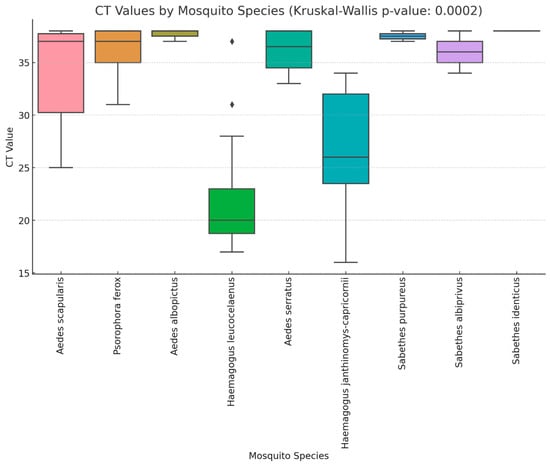
Figure 1
Open AccessArticle
Secondary Metabolites from a New Antibiotic-Producing Endophytic Streptomyces Isolate Inhibited Pathogenic and Multidrug-Resistant Mycobacterium tuberculosis Strains
by
Govinda Raju Vadankula, Arshad Rizvi, Haider Ali, Rakhi Khunjamayum, V. V. Ramprasad Eedara, Vijay Nema, Debananda Singh Ningthoujam, Katragadda Suresh Babu, Prakasham Reddy Shetty, Shekhar C. Mande and Sharmistha Banerjee
Trop. Med. Infect. Dis. 2025, 10(5), 117; https://doi.org/10.3390/tropicalmed10050117 - 23 Apr 2025
Abstract
The long regimen of drug therapy, the emergence of drug-resistance (DR), and infections with non-tuberculous mycobacteria (NTMs) are alarming challenges in controlling tuberculosis (TB), a disease caused by Mycobacterium tuberculosis (M.tb), necessitating the pursuit of new, broad-spectrum anti-mycobacterials. With more than
[...] Read more.
The long regimen of drug therapy, the emergence of drug-resistance (DR), and infections with non-tuberculous mycobacteria (NTMs) are alarming challenges in controlling tuberculosis (TB), a disease caused by Mycobacterium tuberculosis (M.tb), necessitating the pursuit of new, broad-spectrum anti-mycobacterials. With more than two-thirds of the clinically useful antibiotics originating from the bacterial phylum Actinomycetota, and their enormous diversity in India, we explored atypical environments for new bacterial strains with potential anti-M.tb activity. In this study, we the examined the secondary metabolites of soil and endophytic bacterial isolates from the wetland niches of Manipur, India, and determined their anti-mycobacterial properties using viability assays. The ethyl acetate culture filtrate extracts of one of the isolates, named Streptomyces sp. SbAr007, showed broad-spectrum anti-mycobacterial activity against laboratory M.tb strains H37Ra and H37Rv, a clinical drug-resistant M.tb and non-tuberculous mycobacteria (NTM). The isolate was characterized for its phenotype and genetic identity, which indicated its closeness to Streptomyces samsunensis, Streptomyces malaysiensis, and Streptomyces solisilvae. Further, macrophage infection assays showed that the extracts could effectively control the intracellular mycobacterial growth but had negligible cytotoxicity to PBMCs from healthy donors. LC-MS identified an unusual combination of antibiotics in these culture filtrate extracts, which can be further explored for specific active molecules or as a formulation against DR-TB.
Full article
(This article belongs to the Special Issue Biomarkers, Diagnostic, and Therapeutic Approaches for Mycobacterial Diseases)
►▼
Show Figures

Figure 1
Open AccessArticle
Desiccation Tolerance of Aedes aegypti and Aedes albopictus Eggs of Northeastern Argentina Origin
by
Mía E. Martín, Elizabet L. Estallo, Luis G. Estrada, Carolina Matiz Enriquez and Marina Stein
Trop. Med. Infect. Dis. 2025, 10(4), 116; https://doi.org/10.3390/tropicalmed10040116 - 21 Apr 2025
Abstract
This study examines the desiccation tolerance of Aedes aegypti and Aedes albopictus eggs, two major arbovirus vectors, in a subtropical region of Argentina to understand their survival under varying relative humidity (RH) conditions (35%, 68%, and 82%). Laboratory experiments revealed that Ae. aegypti
[...] Read more.
This study examines the desiccation tolerance of Aedes aegypti and Aedes albopictus eggs, two major arbovirus vectors, in a subtropical region of Argentina to understand their survival under varying relative humidity (RH) conditions (35%, 68%, and 82%). Laboratory experiments revealed that Ae. aegypti eggs exhibited significantly higher survival rates across all RH levels and exposure times compared to Ae. albopictus. After 1 month, Ae. aegypti eggs maintained 88% survival at 35% RH, while Ae. albopictus survival dropped to 38%. This disparity was more pronounced at low RH, where Ae. albopictus eggs experienced a rapid decline in survival over time. The results highlight the importance of RH as a key factor influencing the persistence of both species in the environment. The coexistence of Ae. aegypti and Ae. albopictus in Puerto Iguazú suggests that microhabitats with distinct humidity conditions may favor one species over the other. These findings provide crucial insights for predicting mosquito population dynamics under changing climate conditions and developing more effective vector control strategies to reduce arbovirus transmission in subtropical regions.
Full article
(This article belongs to the Special Issue Mosquito-Borne Diseases: Intervention Strategies Used to Control Mosquito Populations and Reduce Disease Transmission)
►▼
Show Figures
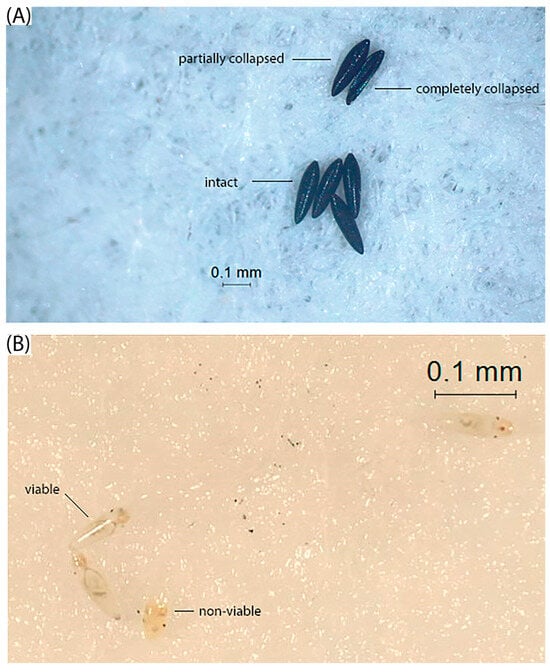
Figure 1
Open AccessReview
The State of Antimicrobial Resistance of Gram-Negative Bacilli in Canada
by
Jeremy Li, Andrew Walkty, Philippe Lagacé-Wiens, James Karlowsky and George Zhanel
Trop. Med. Infect. Dis. 2025, 10(4), 115; https://doi.org/10.3390/tropicalmed10040115 - 21 Apr 2025
Abstract
In the last two decades, there has been an increase in resistance among Gram-negative bacteria in Canada. From 2007 to 2016, the proportion of ESBL-producing isolates among Escherichia coli and Klebsiella pneumoniae isolates increased from 3.5% to 11.1%. There has also been an
[...] Read more.
In the last two decades, there has been an increase in resistance among Gram-negative bacteria in Canada. From 2007 to 2016, the proportion of ESBL-producing isolates among Escherichia coli and Klebsiella pneumoniae isolates increased from 3.5% to 11.1%. There has also been an increase in carbapenem use over this time period, which may be contributing to the increasing prevalence of carbapenemase-producing Enterobacterales (CPE) in Canada. CPE, which were historically associated with travel, are now mostly acquired domestically. The prevalence of multi-drug resistant (MDR) Pseudomonas aeruginosa has decreased slightly, possibly due to decreasing use of fluoroquinolones and aminoglycosides. Many of the most effective antimicrobials for the treatment of infections with resistant Gram-negative organisms, including many of the novel β-lactam/β-lactamase inhibitors (βL/βLIs), are not marketed in Canada. A coordinated focus on antimicrobial stewardship and infection control is necessary to slow the spread of resistance and to preserve the efficacy of our current antimicrobials for future generations.
Full article
(This article belongs to the Special Issue Emerging Trends of Infectious Diseases in Canada)
►▼
Show Figures
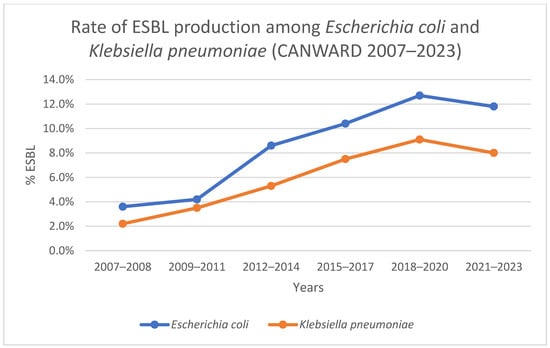
Figure 1
Open AccessArticle
Qualitative Study of Nutritional Support-Related Perceptions and Preferences Among Persons Affected by TB, Family Caregivers, and Healthcare Providers in India
by
Balaji Ramraj, Karikalan Nagarajan, Debjani Ram Purakayastha, Major Madhukar, Makesh Kumar, Neha Raj, Sarath Kumar, Banappa S. Unger, Nithin Rajamani, Sampada Dipak Bangar, Murugesan Periyasamy, Hansraj Choudhary, Yasaswany Santhoshkumar, Ramesh Kumar, Seema Sahay, Nivedita Gupta and Chandrasekaran Padmapriyadarsini
Trop. Med. Infect. Dis. 2025, 10(4), 114; https://doi.org/10.3390/tropicalmed10040114 - 21 Apr 2025
Abstract
Evidence on the implementation aspects of nutritional support interventions for persons with TB in India is limited. This qualitative study employed focus group discussions with persons with TB (n = 71), their family caregivers (n = 17), and healthcare providers (n = 18).
[...] Read more.
Evidence on the implementation aspects of nutritional support interventions for persons with TB in India is limited. This qualitative study employed focus group discussions with persons with TB (n = 71), their family caregivers (n = 17), and healthcare providers (n = 18). The study was conducted from August 2023 to April 2024 in five states in India. Participants’ knowledge, perceptions, and practices about nutritional intake, experiences, and expectations when accessing nutritional support were explored. Four nutrition-related themes emerged: (a) the experiences and perceptions of persons with tuberculosis and their caregivers, explained by their understanding of the importance of adequate nutrition and TB cures; (b) changes in food practices, explained by protein food adoption, alongside food insecurity experienced by those in poverty; (c) Direct Benefit Transfer (DBT)-related issues, explained by insufficiency and access-related gaps; and (d) preferred choices for nutrition support delivery, explained by less preference towards the involvement of intermediaries and a public distribution system alongside preference for the provision of nutrition through treatment facilities. Our findings underscore the importance of the provision of protein-rich food and an increase in financial support based on needs assessments. Mitigating the linkage and access gaps in DBT is needed. The delivery of ready-to-consume food through tuberculosis treatment facilities could be prioritized.
Full article
(This article belongs to the Special Issue Tuberculosis Control in Africa and Asia)
►▼
Show Figures
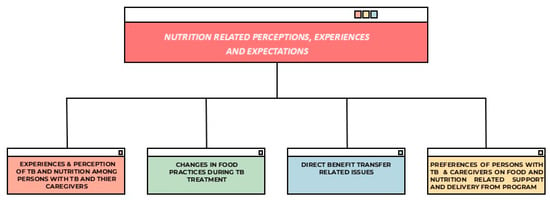
Figure 1
Open AccessSystematic Review
Prevalence of Trichomonas vaginalis Among Women in the Chinese Population: A Systematic Review and Meta-Analysis
by
Shuang Li, Jiahui Xu, Sisi Ru, Changjun Hu, Chongyang Liu, Xingquan Sun, Heteng Guo and Xi Zhang
Trop. Med. Infect. Dis. 2025, 10(4), 113; https://doi.org/10.3390/tropicalmed10040113 - 19 Apr 2025
Abstract
►▼
Show Figures
Trichomonas vaginalis (TV) is the most common non-viral sexually transmitted infection (STI) among women worldwide. However, there is little information available regarding the burden of trichomoniasis infection among Chinese women. The aim of the present study is to assess the status of trichomoniasis
[...] Read more.
Trichomonas vaginalis (TV) is the most common non-viral sexually transmitted infection (STI) among women worldwide. However, there is little information available regarding the burden of trichomoniasis infection among Chinese women. The aim of the present study is to assess the status of trichomoniasis in China. To address this gap, we searched seven databases for relevant studies published from their inception to June 2024. The overall prevalence of T. vaginalis in China was determined to be 6.31% with a high level of heterogeneity (I2 = 99.68%). Subgroup analysis also demonstrated a statistically significant association between the T. vaginalis prevalence in the type of population, age range, year, residential status, and province. Among these, sex workers are the most prominent with 12.16%. Meta-regression analysis indicated that the infection rate of T. vaginalis among Chinese women had not shown a significant decline over time (p = 0.2919). Therefore, it continues to be a public health issue that should not be overlooked. Sex workers and rural women have a relatively higher infection rate of trichomoniasis, and this is largely associated with sexual safety awareness and hygiene conditions. Our findings provide crucial information for healthcare authorities and can shed light on the prevention strategies for trichomoniasis in China.
Full article
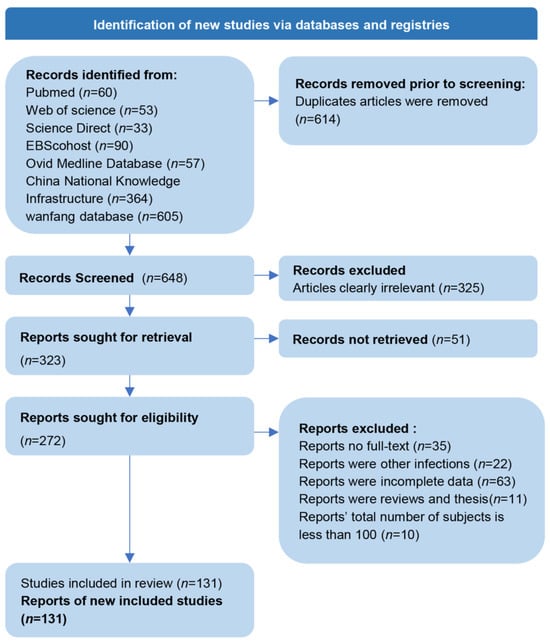
Figure 1
Open AccessArticle
Infectivity and Dissemination of Dengue Virus-1 in Different Aedes aegypti Populations Throughout Brazil
by
Amanda Cupertino de Freitas, Ellen Santos, Lívia Baldon, Silvana de Mendonça, Fernanda Oliveira Rezende, Rafaela Moreira, Viviane Sousa, Mariana Lima, Emanuele Silva, Flávia Ferreira, João Paulo Pereira de Almeida, Siad Amadou, Bruno Marçal, Sara Comini, Marcele Rocha, Yaovi Todjro, Thiago Jiran Leite, Viviane Santos, Isaque João da Silva de Faria, Marta Giovanetti, Luiz Carlos Junior Alcantara, Luciano A. Moreira and Alvaro Ferreiraadd
Show full author list
remove
Hide full author list
Trop. Med. Infect. Dis. 2025, 10(4), 112; https://doi.org/10.3390/tropicalmed10040112 - 19 Apr 2025
Abstract
►▼
Show Figures
Dengue virus, one of the most prevalent mosquito-borne flaviviruses affecting humans globally, is primarily transmitted by the Aedes aegypti mosquito, which thrives in densely populated urban environments. Dengue incidence has surged in recent decades, becoming a major public health concern in many regions,
[...] Read more.
Dengue virus, one of the most prevalent mosquito-borne flaviviruses affecting humans globally, is primarily transmitted by the Aedes aegypti mosquito, which thrives in densely populated urban environments. Dengue incidence has surged in recent decades, becoming a major public health concern in many regions, particularly in Brazil, which has experienced recurrent outbreaks and reported over 6.6 million probable cases in the year of 2024. While the link between the mosquito vector and dengue transmission is well understood, the effects of different DENV types and their interactions with the vector capacity of natural mosquito populations are crucial for understanding disease dynamics. Here we report findings from experiments designed to analyze and compare the infectivity and dissemination of the DENV-1 strain among five Ae. aegypti populations collected from different regions of Brazil. When exposed to DENV-infected AG129 mice for blood feeding, these populations exhibited variations in infection rates and dissemination efficiency. Eight days post-infection, all populations demonstrated high infection rates, underscoring the substantial capacity of Brazilian Ae. aegypti populations to support the locally circulating DENV-1 strain. Our results demonstrate variation in Ae. aegypti vector competence across Brazil, revealing distinct patterns of DENV transmission efficiency. These findings highlight the necessity for geographically tailored control strategies, particularly in high-risk urban areas where outbreak potential is greatest.
Full article
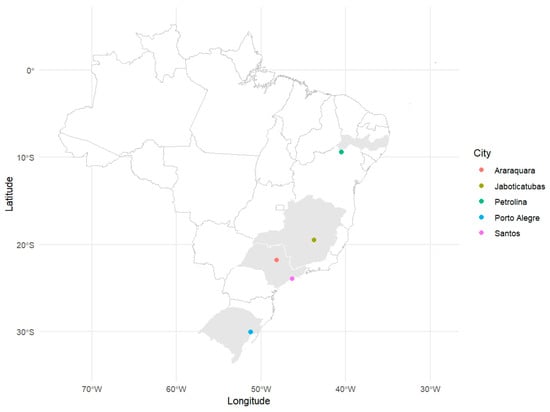
Figure 1
Open AccessArticle
The Incidence of Scabies in Far North Queensland, Tropical Australia: Implications for Local Clinical Practice and Public Health Strategies
by
Mert Hamdi Korkusuz, Maria Eugenia Castellanos, Linton R. Harriss, Allison Hempenstall, Simon Smith and Josh Hanson
Trop. Med. Infect. Dis. 2025, 10(4), 111; https://doi.org/10.3390/tropicalmed10040111 - 18 Apr 2025
Abstract
The recognition and treatment of scabies has been incorporated into Australian guidelines for the prevention of acute rheumatic fever (ARF) and rheumatic heart disease (RHD). The incidence of both diagnosed ARF and RHD is increasing in Far North Queensland (FNQ) in northeast tropical
[...] Read more.
The recognition and treatment of scabies has been incorporated into Australian guidelines for the prevention of acute rheumatic fever (ARF) and rheumatic heart disease (RHD). The incidence of both diagnosed ARF and RHD is increasing in Far North Queensland (FNQ) in northeast tropical Australia, but the local burden of scabies is incompletely defined. We reviewed the results of every skin scraping collected in FNQ’s public health system between 2000 and 2023; 121/4345 (2.8%) scrapings were positive, including 19/1071 (1.8%) in the last 5 years of the study; the proportion of scrapings that were positive for scabies declined over the study period. Individuals who tested positive for scabies were no more likely to have had a prior diagnosis of ARF or RHD compared to the matched controls (1/101 (1%) versus 3/101 (3%), p = 1.0). During a median of 14.7 years of follow-up, individuals who tested positive for scabies were also no more likely to have a diagnosis of ARF or RHD than matched controls (2/100 (2%) versus 6/98 (6%); hazard ratio (95% confidence interval): 0.30 (0.06–1.50) p = 0.14). Microbiologically confirmed scabies is uncommon in FNQ and appears to make a limited contribution to the local incidence of ARF and RHD.
Full article
(This article belongs to the Section Neglected and Emerging Tropical Diseases)
►▼
Show Figures
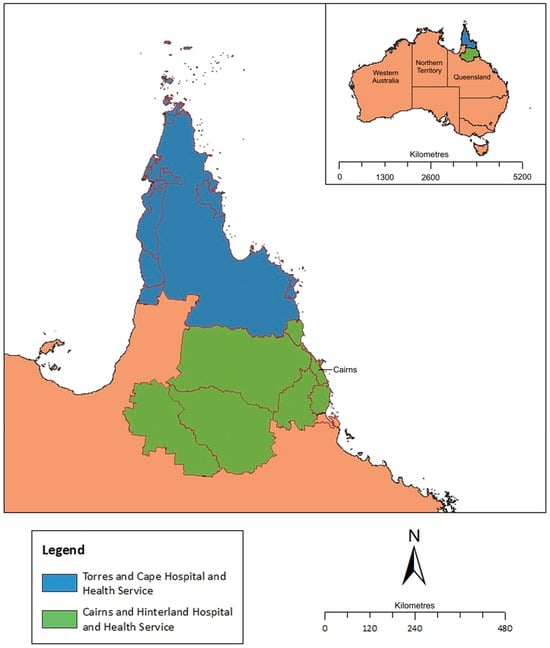
Figure 1
Open AccessCase Report
Non-O1, Non-O139 Vibrio cholerae Bacteremic Skin Infection with Multiple Skin Necrosis: Case Report
by
Amer Ibrahim Alomar, Nasreldin Elhadi, Lamya Zohair Yamani, Reema Allahham, Rana Alghamdi, Ibrahim Alhabib, Asim Diab, Nehal Mahmoud, Bashayer AlDossary, Mariam Almejhim, Nouf Al-Romihi, Faye Aldehalan and Reem Al Jindan
Trop. Med. Infect. Dis. 2025, 10(4), 110; https://doi.org/10.3390/tropicalmed10040110 - 17 Apr 2025
Abstract
►▼
Show Figures
Non-O1, non-O139 Vibrio cholerae (NOVC) extraintestinal infections are rare, but recently, several clinical incidents have been reported worldwide. Toxigenic V. cholerae is a well-known etiological agent of cholera, responsible for acute dehydrating watery diarrhea. Outbreaks occur in an epidemic seasonal pattern, particularly in
[...] Read more.
Non-O1, non-O139 Vibrio cholerae (NOVC) extraintestinal infections are rare, but recently, several clinical incidents have been reported worldwide. Toxigenic V. cholerae is a well-known etiological agent of cholera, responsible for acute dehydrating watery diarrhea. Outbreaks occur in an epidemic seasonal pattern, particularly in countries with poverty and poor sanitation. Strains of NOVC are usually not involved in causing the epidemic or pandemic outbreaks seen with potential strains of V. cholerae serogroup O1 and O139. However, they can still cause severe sporadic cases of intestinal as well as extraintestinal infections. In this study, we investigated a case of extraintestinal infections associated with the NOVC serogroup isolated from a deep closed wound abscess. The isolate was screened for the presence of three major virulence genes, toxR, ctxA, and tcpA. The strain tested positive for the toxR gene encoding the regulatory protein and cholera toxin (ctx) gene and tested negative for the toxin-coregulated pilus (TCP) gene, which is essential for the colonization of the human intestine, causing the severe diarrheal disease cholera. To the best of our knowledge, this is the first case of extraintestinal infection caused by toxigenic Vibrio cholerae non-O1/non-O139 in a hospitalized patient in Saudi Arabia.
Full article
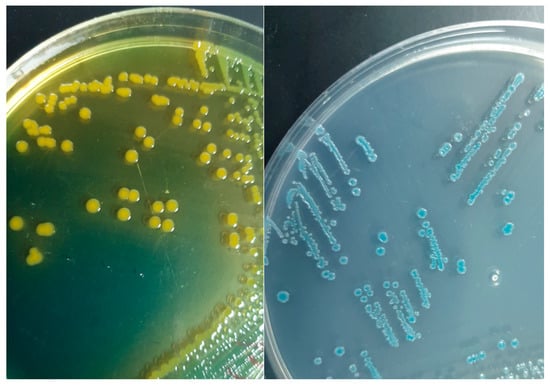
Figure 1
Open AccessArticle
Phylogeographic Patterns and Genetic Diversity of Anopheles stephensi: Implications for Global Malaria Transmission
by
Jehangir Khan, Dongjing Zhang, Saber Gholizadeh, Yidong Deng, Abdul Aziz, Jianhuang Chen, Pir Tariq Shah, Zhiyue Lv and Tao Chen
Trop. Med. Infect. Dis. 2025, 10(4), 109; https://doi.org/10.3390/tropicalmed10040109 - 16 Apr 2025
Abstract
►▼
Show Figures
Background: Anopheles stephensi, a primary malaria vector in South Asia, is expanding its geographic range, raising concerns about increased malaria transmission. However, critical aspects of its genetic diversity, population structure, and evolutionary dynamics remain poorly understood in Khyber Pakhtunkhwa (KP), Pakistan,
[...] Read more.
Background: Anopheles stephensi, a primary malaria vector in South Asia, is expanding its geographic range, raising concerns about increased malaria transmission. However, critical aspects of its genetic diversity, population structure, and evolutionary dynamics remain poorly understood in Khyber Pakhtunkhwa (KP), Pakistan, an endemic malaria region where An. stephensi is adapting to urban settings, posing challenges for the development of targeted vector control strategies. This study addresses this gap by analyzing COI, COII (cytochrome oxidase subunit I and II), and ITS2 (internal transcribed spacer 2) sequences from An. stephensi populations in KP and comparing them with global isolates. Additionally, egg morphology analysis was conducted to identify the biological form. Methods: Mosquitoes were collected from malaria-endemic districts (Nowshera, Charsadda, and Peshawar) using ovitraps. Eggs were characterized morphologically, and DNA was extracted for PCR amplification of COI, COII, and ITS2 markers. Sequences from 17 Pakistani isolates, along with global sequences, were analyzed. Phylogenetic relationships, haplotype networks, genetic diversity, and neutrality tests (Tajima’s D and Fu’s Fs) were assessed. Results: Egg morphology confirmed the mysorensis form (13–15 ridges per egg) in KP. COI sequences clustered into two subclades (Punjab and KP), with >99% similarity to global isolates. COII and ITS2 sequences showed high similarity (99.46–100%) with populations from China, Iran, India, and Brazil, reflecting strong genetic connectivity rather than distinct regional clustering. Haplotype analysis identified six COI, ten COII, and ten ITS2 haplotypes, with Hap_2 (50.7%) and Hap_1 (43.3%) being the most prevalent in COI, Hap_7 (29.4%) in COII, and Hap_3 (80.8%) in ITS2. Population genetic analysis revealed higher COI diversity in Pakistan and India, with moderate diversity in COII. Neutrality tests suggested balancing selection in COI for both countries, while COII and ITS2 indicated population contraction in Iran. Conclusions: The findings reveal strong genetic connectivity within regions (e.g., Pakistan) and differentiation across global populations of An. stephensi, highlighting its potential for further expansion and adaptation. These insights are critical for informing global malaria control strategies, particularly in regions vulnerable to vector invasion.
Full article

Figure 1
Open AccessArticle
Current Antimicrobial Susceptibility Trends and Clinical Outcomes of Typhoidal Salmonella in a Large Health Authority in British Columbia, Canada
by
Calvin Ka-Fung Lo, Merisa Mok, Cole Schonhofer, Kevin Afra and Shazia Masud
Trop. Med. Infect. Dis. 2025, 10(4), 108; https://doi.org/10.3390/tropicalmed10040108 - 15 Apr 2025
Abstract
Background: From 2018 to 2021, travel-related extensively drug-resistant (XDR) Salmonella Typhi was identified in Ontario, Canada. Opportunities remain to characterize typhoidal Salmonella antimicrobial susceptibility trends (including multi-drug resistance phenotypes; MDR) within a large health authority in British Columbia, Canada. Methods: This retrospective study
[...] Read more.
Background: From 2018 to 2021, travel-related extensively drug-resistant (XDR) Salmonella Typhi was identified in Ontario, Canada. Opportunities remain to characterize typhoidal Salmonella antimicrobial susceptibility trends (including multi-drug resistance phenotypes; MDR) within a large health authority in British Columbia, Canada. Methods: This retrospective study included patients with Salmonella Typhi or Paratyphi A, B or C bacteremia identified at Fraser Health regional microbiology laboratory from 2018 to 2024. The primary outcome was the proportion of cases with MDR and XDR typhoidal Salmonella. Secondary outcomes included annual antimicrobial susceptibility for ampicillin, ceftriaxone, ciprofloxacin, trimethoprim-sulfamethoxazole, ertapenem, meropenem and azithromycin. Clinical outcomes included hospitalization length, and 30-day mortality, clinical cure and infection relapse. Results: Among 271 patients, most were previously healthy and recently travelled. There were extended spectrum beta-lactamase (1.1%) and MDR (1.5%) typhoidal Salmonella, with no XDR cases observed. In 2024, ciprofloxacin resistance was 96% while susceptibility rates were high for other studied antimicrobials. Within 30 days, no deaths were reported; however, six patients (3%) had infection relapse. Conclusions: Currently, in British Columbia, MDR typhoidal Salmonella remains rare. Empiric ciprofloxacin should be avoided due to persistently high resistance rates. With ongoing travel patterns, it is beneficial for institutions to continue typhoidal Salmonella antimicrobial susceptibility surveillance, and travelers should seek pre-travel health assessments.
Full article
(This article belongs to the Special Issue Emerging Trends of Infectious Diseases in Canada)
Open AccessCase Report
Osteomyelitis Caused by Moesziomyces aphidis in an Immunocompetent Adult: A Case Report and Literature Review
by
Yi-Ying Chen, Ting-Kuang Yeh, Chi-Jung Wu and Po-Yu Liu
Trop. Med. Infect. Dis. 2025, 10(4), 107; https://doi.org/10.3390/tropicalmed10040107 - 14 Apr 2025
Abstract
Osteomyelitis caused by Moesziomyces aphidis is exceedingly rare and, to our knowledge, has not been previously reported in immunocompetent individuals. This case represents the first documented instance. A 19-year-old woman developed osteomyelitis following an open right leg fracture sustained in a traffic accident.
[...] Read more.
Osteomyelitis caused by Moesziomyces aphidis is exceedingly rare and, to our knowledge, has not been previously reported in immunocompetent individuals. This case represents the first documented instance. A 19-year-old woman developed osteomyelitis following an open right leg fracture sustained in a traffic accident. Initial cultures yielded an unidentified yeast, later identified as M. aphidis through internal transcribed spacer sequencing. The patient demonstrated clinical improvement with combination therapy of amphotericin B and following oral voriconazole. This case underscores the emerging pathogenic potential of Moesziomyces spp., particularly in the setting of trauma and open wounds, and highlights the importance of including this genus in the differential diagnosis of osteomyelitis. A literature review indicates that Moesziomyces infections are predominantly observed in immunocompromised patients, especially in Asia. However, our case underscores the need for greater awareness of this emerging pathogen in immunocompetent hosts as well.
Full article
(This article belongs to the Special Issue Monitoring and Diagnosis of Invasive Fungal Infections)
Open AccessArticle
Treatment-Decision Algorithm of Child TB: Evaluation of WHO Algorithm and Development of Indonesia Algorithm
by
Rina Triasih, Finny Fitry Yani, Diah Asri Wulandari, Betty Weri Yolanda Nababan, Muhammad Buston Ardiyamustaqim, Fransiska Meyanti, Sang Ayu Kompiyang Indriyani, Tiffany Tiara Pakasi and Ery Olivianto
Trop. Med. Infect. Dis. 2025, 10(4), 106; https://doi.org/10.3390/tropicalmed10040106 - 14 Apr 2025
Abstract
Clinical algorithms for child tuberculosis (TB) are a valuable guide for healthcare workers to initiate treatment. We evaluated the agreement of pediatric TB diagnosis using the current Indonesia diagnostic algorithms with the 2022 WHO treatment decision algorithm and developed a new Indonesia algorithm
[...] Read more.
Clinical algorithms for child tuberculosis (TB) are a valuable guide for healthcare workers to initiate treatment. We evaluated the agreement of pediatric TB diagnosis using the current Indonesia diagnostic algorithms with the 2022 WHO treatment decision algorithm and developed a new Indonesia algorithm for child TB based upon our findings and expert opinion. We conducted a retrospective study at 10 hospitals in Indonesia, involving children (0–10 years), who were evaluated for TB diagnosis in 2022. A panel of child TB experts used participants’ records to make a diagnosis using the 2022 WHO algorithm and the 2016 Indonesian algorithm. We assessed agreement between the diagnosis made by the attending doctor and those determined by the expert panel. A new Indonesia guideline was developed based on the findings and consensus of various stakeholders. Of 523 eligible children, 371 (70.9%) were diagnosed with TB by the attending doctors, 295 (56.4%) by the WHO algorithm, and 246 (47%) by the Indonesia algorithm. The Cohen’s Kappa of TB diagnosis was: attending doctor vs. WHO algorithm (0.27), attending doctor vs. Indonesia algorithm (0.45), and WHO algorithm vs. Indonesia algorithm (0.42). A review of both algorithms revealed challenges for implementation. An algorithmic approach for child TB diagnosis may not be universally applicable or implementable due to variable access to diagnostic tests and the wide variety of clinical presentations.
Full article
(This article belongs to the Special Issue Implementing TB Elimination Approaches in Indonesia: Operational Research on Case Finding, Treatment and Prevention of TB in Yogyakarta and Timika)
►▼
Show Figures
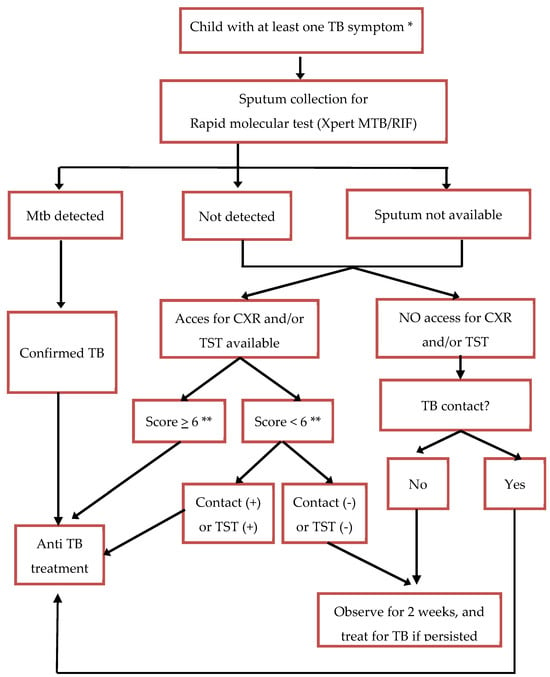
Figure 1
Open AccessReview
The Antimicrobial Resistance–Water–Corporate Interface: Exploring the Connections Between Antimicrobials, Water, and Pollution
by
Jason P. Burnham
Trop. Med. Infect. Dis. 2025, 10(4), 105; https://doi.org/10.3390/tropicalmed10040105 - 12 Apr 2025
Abstract
Antibiotic resistance is a public health emergency, with ten million deaths estimated annually by the year 2050. Water systems are an important medium for the development and dissemination of antibiotic resistance from a variety of sources, explored in this perspective review. Hospital wastewater
[...] Read more.
Antibiotic resistance is a public health emergency, with ten million deaths estimated annually by the year 2050. Water systems are an important medium for the development and dissemination of antibiotic resistance from a variety of sources, explored in this perspective review. Hospital wastewater and wastewater systems more broadly are breeding grounds for antibiotic resistance because of the nature of their waste and how it is processed. Corporations from various sectors contribute to antibiotic resistance in many direct and indirect ways. Pharmaceutical factory runoff, agricultural antibiotic use, agricultural use of nitrogen fertilizers, heavy metal pollution, air pollution (atmospheric deposition, burning of oil and/or fossil fuels), plastic/microplastic pollution, and oil/petroleum spills/pollution have all been demonstrated to contribute to antibiotic resistance. Mitigation strategies to reduce these pathways to antibiotic resistance are discussed and future directions hypothesized.
Full article
(This article belongs to the Special Issue Pathogen-Host-Environment Interactions: One-Health Perspectives and Solutions in Antimicrobial Resistance and Disease)
►▼
Show Figures
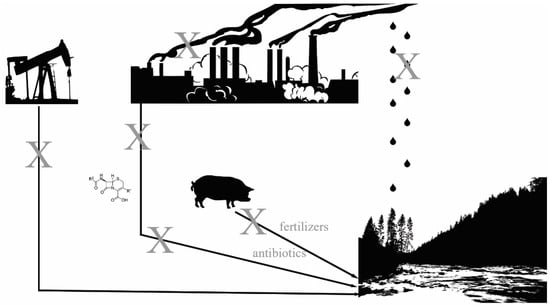
Figure 1
Open AccessBrief Report
Detection of Trypanosoma cruzi in a Reactive Blood Bank Sample in Sonora, Mexico
by
Idalia Paredes-Sotelo, Mónica Reséndiz-Sandoval, Adriana Garibay-Escobar, Edgar Alfonso Paredes-González, Aracely Angulo-Molina, Angel Ramos-Ligonio, Eric Dumonteil, Claudia Herrera and Olivia Valenzuela
Trop. Med. Infect. Dis. 2025, 10(4), 104; https://doi.org/10.3390/tropicalmed10040104 - 11 Apr 2025
Abstract
Chagas disease is a neglected disease caused by the parasite Trypanosoma cruzi, a public health problem in both endemic and non-endemic countries. In Mexico, the southern region is considered endemic, and cases are frequently reported; however, in the northwestern region, only a
[...] Read more.
Chagas disease is a neglected disease caused by the parasite Trypanosoma cruzi, a public health problem in both endemic and non-endemic countries. In Mexico, the southern region is considered endemic, and cases are frequently reported; however, in the northwestern region, only a few cases are confirmed annually. This study describes, for the first time, the Discrete Typing Unit (DTU) of Trypanosoma cruzi in a volunteer blood donor rejected for being reactive in the northwestern region of Mexico. Seroreactivity was confirmed using “in-house” ELISAs which employed three different antigens: total extract from Trypanosoma cruzi isolated from a vector (Triatoma rubida) from Sonora (strain T1), strain H1 and CL-Brener. The molecular characterization of Trypanosoma cruzi was conducted by amplifying satellite DNA by qPCR and posterior sequencing of the mini-exon gene, using Next Generation Sequencing (NGS) to enhance the accuracy of genetic characterization. The results show that the reactive status of this blood donor was confirmed using our in-house ELISAs, and the presence of Trypanosoma cruzi by detecting TcI DTU confirmed the infection status.
Full article
(This article belongs to the Special Issue Emerging Vector-Borne Diseases and Public Health Challenges)
►▼
Show Figures
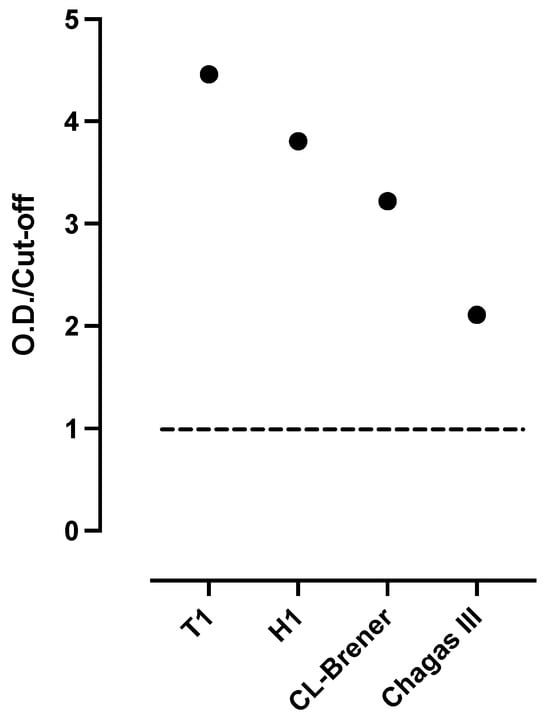
Figure 1
Open AccessArticle
Using a Machine Learning Approach to Predict Snakebite Envenoming Outcomes Among Patients Attending the Snakebite Treatment and Research Hospital in Kaltungo, Northeastern Nigeria
by
Nicholas Amani Hamman, Aashna Uppal, Nuhu Mohammed, Abubakar Saidu Ballah, Danimoh Mustapha Abdulsalam, Frank Mela Dangabar, Nuhu Barde, Bello Abdulkadir, Suraj Abdullahi Abdulkarim, Habu Dahiru, Idris Mohammed, Trudie Lang and Joshua Abubakar Difa
Trop. Med. Infect. Dis. 2025, 10(4), 103; https://doi.org/10.3390/tropicalmed10040103 - 11 Apr 2025
Abstract
The Snakebite Treatment and Research Hospital (SBTRH) is a leading centre for snakebite envenoming care and research in sub-Saharan Africa, treating over 2500 snakebite patients annually. Despite routine data collection, routine analyses are seldom conducted to identify trends or guide clinical practices. This
[...] Read more.
The Snakebite Treatment and Research Hospital (SBTRH) is a leading centre for snakebite envenoming care and research in sub-Saharan Africa, treating over 2500 snakebite patients annually. Despite routine data collection, routine analyses are seldom conducted to identify trends or guide clinical practices. This study retrospectively analyzes 1022 snakebite cases at SBTRH from January to June 2024. Most patients were adults (62%) and were predominantly male (72%). Key factors such as age, sex, and time between bite and hospital presentation were associated with outcomes, including recovery, amputation, debridement, and death. Adult males who took more than four hours to arrive to hospital were identified as a high-risk group for poor outcomes. Using patient characteristics, an XGBoost model was developed and was compared to Random Forest and logistic regression models. In general, all models had high positive predictive value and low sensitivity, meaning that if they predicted a patient to experience amputation, debridement, or death, that patient almost always actually experienced amputation, debridement, or death; however, most models rarely made this prediction. The XGBoost model with all features was optimal, given that it had both a high positive predictive value and relatively high sensitivity. This may be of significance to resource-limited settings like SBTRH, where antivenoms can be scarce; however, more research is needed to build better predictive models. These findings underscore the need for targeted interventions for high-risk groups, and further research and integration of machine-learning-driven decision support tools in low-resource-limited clinical settings.
Full article
(This article belongs to the Special Issue Snake Bite: Prevention, Diagnosis and Treatment)
Open AccessArticle
Community-Based Tuberculosis Preventive Treatment Among Child and Adolescent Household Contacts in Ethiopia
by
Eshetu Abelti, Zewdu Dememew, Asfawesen Gebreyohannes, Yohannes Alemayehu, Tilay Terfassa, Taye Janfa, Degu Jerene, Pedro Suarez and Daniel Datiko
Trop. Med. Infect. Dis. 2025, 10(4), 102; https://doi.org/10.3390/tropicalmed10040102 - 9 Apr 2025
Abstract
There are limited studies on the community-based outcomes of tuberculosis (TB) preventive treatment (TPT) among children and adolescent contacts <15 years in Ethiopia. Our objective was to assess TPT uptake and completion rates among eligible under-15-year-old TB household contacts through an enhanced community-based
[...] Read more.
There are limited studies on the community-based outcomes of tuberculosis (TB) preventive treatment (TPT) among children and adolescent contacts <15 years in Ethiopia. Our objective was to assess TPT uptake and completion rates among eligible under-15-year-old TB household contacts through an enhanced community-based model of interventions. The study was conducted between July 2021 and June 2022 in twenty primary health care units in the Sidama and Southern Nations, Nationalities, and Peoples’ Region (SNNPR) regions. A total of 4367 (99.2%) household contacts of 1069 bacteriologically confirmed PTB index cases were symptomatically screened for TB by trained health extension workers (HEWs) at the community level. A total of 696 (15.9%) symptomatic contacts were identified, of which 694 (99.7%) were evaluated for TB, resulting in 60 (8.6%) TB cases. A total of 1567 (95.3%) asymptomatic children and adolescent contacts <15 years of age were initiated on TPT (88.8%) at health posts in the community. After the interventions, there was a significant increase in contact screening coverage (95.6% vs. 99.2%, Odds Ratio (OR), 5.54; 95% Confidence interval (CI), 2.93–10.13) and TPT uptake (81.7% vs. 95.4%; OR, 4.67; 95% CI, 2.54–8.23). The TPT completion rate was also 98.1% (of 1567). The TPT completion rate at health posts in the community was higher than the rate at health centers (99.4% vs. 88.0%; OR, 20.95; 95% CI, 8.97–52.71). TPT uptake and completion in children and adolescent contacts could be improved remarkably with the implementation of an enhanced community-based model of intervention in high-TB-burden districts.
Full article
(This article belongs to the Special Issue Tuberculosis Control in Africa and Asia)
►▼
Show Figures
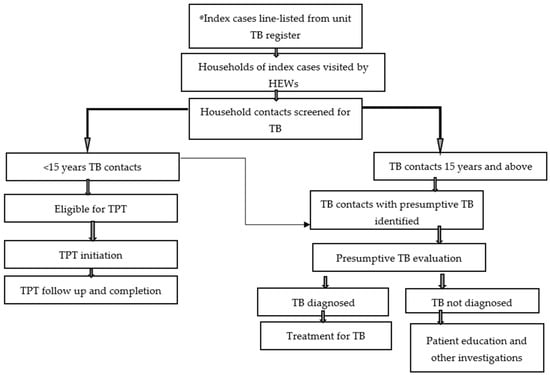
Figure 1
Open AccessArticle
Breaking the Cycle of Echinococcosis: A Mathematical Modeling Approach
by
Richard Lagos, Juan Pablo Gutiérrez-Jara, Beatriz Cancino-Faure, Leidy Yissedt Lara-Díaz, Ignacio Barradas and Andrei González-Galeano
Trop. Med. Infect. Dis. 2025, 10(4), 101; https://doi.org/10.3390/tropicalmed10040101 - 9 Apr 2025
Abstract
This study presents a mathematical model of the transmission and spread of the Echinococcus granulosus parasite. The model incorporates host mobility, laws governing the dynamics of Echinococcosis transmission between hosts, and control and prevention measures. The basic reproductive number of the proposed model
[...] Read more.
This study presents a mathematical model of the transmission and spread of the Echinococcus granulosus parasite. The model incorporates host mobility, laws governing the dynamics of Echinococcosis transmission between hosts, and control and prevention measures. The basic reproductive number of the proposed model is calculated, and a sensitivity analysis is performed to identify the parameters that most influence the dynamics of transmission and spread of the disease among its hosts. The study evaluates two control strategies—dog deworming and sheep vaccination—based on their respective target reproductive numbers. The impact of these control and prevention measures is investigated through numerical simulations, which reveal that the dog deworming strategy consistently reduces infections in humans. In contrast, the sheep vaccination strategy demonstrates a more favorable scenario for disease eradication in both hosts. In addition, simulations show a close relationship between the early detection of the disease and the recovery of the patient.
Full article
(This article belongs to the Special Issue Advancing One Health Approaches for Public Health and Zoonotic Neglected Tropical Diseases Control in Latin America and the Caribbean)
►▼
Show Figures
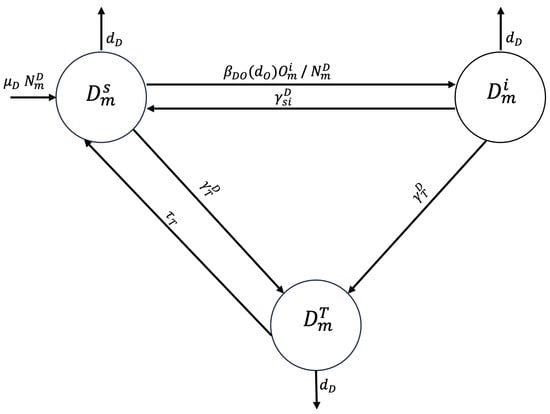
Figure 1
Open AccessArticle
HPV Genotype Trends in Iran: Necessity for a Reevaluation of Prevention Strategies
by
Maryam Shahi, Azam Shafaei, Mohamad Ghodsi, Reza Jafarzadeh Esfehani and Mahdi Moradi Marjaneh
Trop. Med. Infect. Dis. 2025, 10(4), 100; https://doi.org/10.3390/tropicalmed10040100 - 8 Apr 2025
Abstract
Introduction: Human papillomavirus (HPV) genotyping is critical for preventing and managing HPV-related health issues, including cancers. This study re-evaluates HPV genotype trends in Iran to inform prevention strategies. Materials and Methods: A cross-sectional analysis of HPV genotyping data from individuals tested at the
[...] Read more.
Introduction: Human papillomavirus (HPV) genotyping is critical for preventing and managing HPV-related health issues, including cancers. This study re-evaluates HPV genotype trends in Iran to inform prevention strategies. Materials and Methods: A cross-sectional analysis of HPV genotyping data from individuals tested at the ACECR Khorasan Razavi molecular laboratory in Iran (2016–2022) was conducted, with a forecast of genotype trends through 2027. Results: Among 5009 female patients, 40.4% tested positive for HPV (mean age: 32 ± 8.77 years), with a significant upward trend in positivity over time (tau = 0.905, p = 0.0069). HPV 6, 11, 16, 31, 53, and 54 showed significant increases (p < 0.01), while HPV 66, 84, 67, and 35 exhibited notable trends (p < 0.05). HPV 18 and 33 had marginal trends (p = 0.065, p = 0.052), and HPV 68, 70, and 82 remained stable. Linear regression indicated a non-significant decline in low-risk HPV cases (R = 0.703, p = 0.078) and negligible change in high-risk cases (R = 0.052, p = 0.912). Forecasts predicted increases in HPV 84, 54, 43, 42, and 26, with HPV 6 projected to decrease significantly. HPV 44, 73, and 33 were expected to remain stable. Conclusion: While low-risk HPV cases may decline, the trend lacks statistical significance, and high-risk HPV cases show no change. These findings underscore the need for targeted prevention strategies in Iran, particularly for high-risk genotypes, to reduce the burden of HPV-related cancers. Further research is essential to validate these trends and refine public health interventions.
Full article
(This article belongs to the Special Issue Molecular Epidemiology of Human Papillomavirus Infection)
►▼
Show Figures
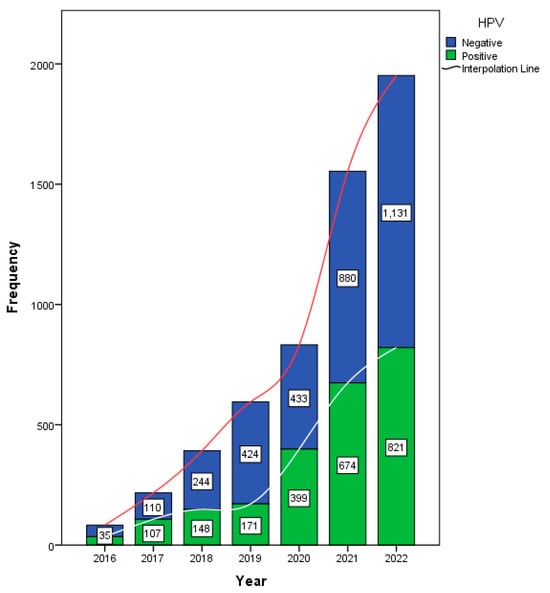
Figure 1

Journal Menu
► ▼ Journal Menu-
- TropicalMed Home
- Aims & Scope
- Editorial Board
- Topical Advisory Panel
- Instructions for Authors
- Special Issues
- Topics
- Sections & Collections
- Article Processing Charge
- Indexing & Archiving
- Editor’s Choice Articles
- Most Cited & Viewed
- Journal Statistics
- Journal History
- Journal Awards
- Society Collaborations
- Conferences
- Editorial Office
Journal Browser
► ▼ Journal BrowserHighly Accessed Articles
Latest Books
E-Mail Alert
News
Topics
Topic in
Infectious Disease Reports, Insects, IJERPH, Pathogens, TropicalMed, Zoonotic Diseases
Vector-Borne Disease Spatial Epidemiology, Disease Ecology, and Zoonoses
Topic Editors: Chad L. Cross, Louisa Alexandra MessengerDeadline: 31 December 2025

Conferences
Special Issues
Special Issue in
TropicalMed
New Perspectives and Innovations in Prosthetic Joint Infections
Guest Editors: Novella Cesta, Rareş Mircea BîrluţiuDeadline: 30 April 2025
Special Issue in
TropicalMed
Epidemiology of Vector-Borne Diseases: One Health Approach
Guest Editor: Kazi RahmanDeadline: 30 April 2025
Special Issue in
TropicalMed
Emerging and Re-emerging Infectious Diseases and Public Health
Guest Editors: Valeriu I. Gheorghiţǎ, Simin-Aysel FlorescuDeadline: 30 April 2025
Special Issue in
TropicalMed
Insecticide Resistance and Vector Control
Guest Editors: Adriana Flores Suárez, Jesus Davila-Barboza, Alan E. Juache-VillagranaDeadline: 30 April 2025
Topical Collections
Topical Collection in
TropicalMed
Infection Prevention and Control: Practical and Educational Advances
Collection Editors: Constantinos Tsioutis, Spyridon Karageorgos, Nico Mutters, Carlos Palos





